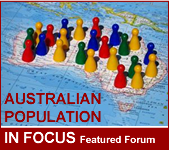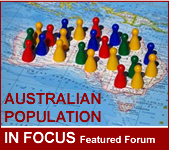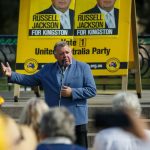Population strategy cannot be viewed in isolation
The Hon Anthony Roberts | September 23, 2011

The Hon. Anthony Roberts MP, NSW Minister for Fair Trading, delivered the following opening address at Global Access Partners’ National Economic Review 2011: Australia’s Annual Growth Summit on Friday 16 September 2011.
I’d like to start by thanking Global Access Partners for inviting me to address this audience of policy makers, industry leaders and academics, and to discuss and debate the opportunities and impact of population growth.
Here in this Parliament, is where the big ideas should be debated. They have an enormous impact on the lives of current and future Australians.
The simple reality is that we are growing as this debate unfolds.
A debate on population and economic growth is often marked in rather simplistic terms, by the outer parameters. ‘Big or small’ becomes the question. That is, there is the argument that Australia and usually most notably New South Wales, is nearing the upper reaches of an appropriate and sustainable population size and all efforts should be directed at stabilising our population at, or not too far away from current levels. The alternative position is that a pro-population growth strategy is essential to ensure Australia’s ongoing prosperity.
 Each side of the debate holds up a quality of life argument to support its position. One thing all agree is that population strategy cannot be viewed in isolation. Governments at all levels must set the right policies.
Each side of the debate holds up a quality of life argument to support its position. One thing all agree is that population strategy cannot be viewed in isolation. Governments at all levels must set the right policies.I note that last year’s Summit highlighted the lack of spending on infrastructure as a serious inhibitor of economic growth.
The New South Wales Coalition Government understands that there must be sustained, integrated and targeted investment in the infrastructure that all people in this state and indeed other parts of Australia, rely upon. They rely on infrastructure to get to work, to sporting and cultural events; they rely on our health infrastructure, our basic services and housing.
However, it is the secondary or knock-on effect of infrastructure investment that pays into the long term. The right kind and level of infrastructure investment pays off.
Infrastructure investment has the capacity to initially provide indirect and direct jobs during the construction phase. Even more importantly, targeted and integrated investment of this nature releases and enhances the productive capacities of our people and our economy.
A commitment to infrastructure spending is a commitment to the future. It demonstrates that we are continuing to build on what we have, as well as creating the building blocks that support our community and our economy.
Whilst the debate on how big Australia should be continues, our population steadily grows. We may continue to ponder, debate and consider the population question, but regardless of the outcome, there is an urgent need to better cater for our communities now and better prepare our economy for the larger communities and their needs and aspirations — that we will certainly have in the future.
We know that spending needs to be directed to those projects which we can alleviate the bottlenecks that apply a brake to different sectors of the economy.
The establishment of Infrastructure New South Wales is an important initiative and the centrepiece of our commitment to ensure that infrastructure spending addresses the key issues. This new body is improving the way that infrastructure is assessed and delivered in this State. Indeed, its initial priority is to develop a twenty year Infrastructure State Strategy.
Legislation to establish Infrastructure New South Wales passed through the Parliament in June and we have appointed some outstanding people to the Board drawn from the best of both the private and public sectors. Through the development of a clear long term strategy, we will manage and build on our existing infrastructure. This strategy will ensure that we address or avert emerging bottlenecks to industry and are well placed to manage the impact of population growth.
To deliver against a worthwhile strategy requires genuine commitment. Only a serious government with an eye to the future and confidence in the course it has set can hope to achieve this.
The New South Wales Liberal & Nationals Government’s commitment to infrastructure is evident in the budget handed down last week. The fast tracking of the North West Rail Link and the accompanying initial allocation of 314 million dollars will ensure that the people in the middle of the population boom in this area of Sydney finally get the transport infrastructure they need. This investment is part of the biggest infrastructure commitment in the history of this state — 62.6 billion over the next four years will be spent on building up our infrastructure asset base.
The impact of an expanding population is very much evident in New South Wales. It is particularly obvious in Sydney which has suffered from years of underinvestment in infrastructure whilst remaining the number one destination of choice for those choosing to immigrate to Australia.
A first order issue is housing. Everyone needs somewhere to live.
The New South Wales Coalition’s first budget, together with the release of the State Plan, included major announcements on housing initiatives. Ten thousand new blocks of land will be released for housing over the next four years, providing even more opportunities for people to enter the real estate market and purchase their own home. In line with our election commitment we are also reviewing the Planning Act to ensure that it provides greater certainty for both investors and residents. The planning system must be transparent and facilitate a flexible and sustainable approach to housing and our environment.
In my portfolio of Fair Trading we administer the laws that govern residential tenancies and strata living. There are some 70,000 strata schemes and 1,500 community schemes currently operating in NSW. It is estimated that about one quarter of the population of New South Wales live, own or are employed within a strata scheme and this number is growing. This makes it an important element of any strategy to deal with a growing population.
New South Wales established itself as a state prepared to reconsider how property and housing is managed by instituting the first system of strata title in 1961. This model has since been adopted throughout Australia and the world. Indeed, this year is the 50th anniversary of strata laws. I understand that the world’s first strata scheme, imaginatively named — ‘Strata Plan Number One’ — is still in existence.
In addition to the co-ordinated and timely release of land for housing in New South Wales, it is essential that we manage our existing stock effectively. This includes a sensible and sustainable approach to the issue of population density in our metropolitan areas.
An improved, modern and more flexible framework for strata is essential. Improving the governance of strata schemes through better financial management is another important element of potential reform in this area. Better planning laws, more flexible rules around how multi-storey or strata arrangements work, are but two elements involved in addressing our population and demographic challenges.
Often the discussion on infrastructure needs and investment focuses almost exclusively on matters that are city or Sydney centric. The O’Farrell Stoner Government will ensure that a co-ordinated approach to population is taken.
We need balanced population growth across the State. The New South Wales Government is aiming to increase the population in the regions by 470,000 by 2036. We are working with regional communities, business and local government to target new investment in priority regional infrastructure. This work will ensure that more people who do not live in Sydney are able to access the basic economic and lifestyle opportunities on offer in this State. This considered and strategic approach to population will relieve some of the congestion pressures that exist across Sydney.
In June the Treasurer and Deputy Premier announced the Regional Relocation Grants program to encourage population and economic growth in regional New South Wales. The New South Wales State Plan sets out the Our Jobs Action Plan which will assist business investment and growth aiming to create 40,000 new jobs across the State. Our Resources for Regions policy will see Infrastructure New South Wales administer a range of new infrastructure programs.
Population growth is one thing — the composition of our population, our communities, is another. One of the well-known demographic challenges we face is that brought on by the ageing profile of our population.
We know that over the next 25 years, the number of people aged 65 or older is expected to double. To meet the challenges of an ageing population this Government is completing a demographic plan on ageing and developing a whole of government Ageing Strategy. Such an approach is absolutely critical as we face up to a demographic shift which is expected to challenge growth, increase demand for health services and even alter transport in this state.
In my portfolio we are considering how to better address the housing needs of older citizens through the retirement villages legislation. Through the simplification of consumer contracts with retirement village operators we will make it easier for consumers to compare conditions and prices at different centres.
The demand for retirement accommodation continues to increase as expected, with the ageing of our population. We need to ensure that the policy settings we choose in New South Wales encourage the kind of investment necessary to provide an adequate supply of the highest quality retirement village housing stock. Success will benefit many Australians and their families.
In its recent report Caring for Older Australians, the Productivity Commission noted that the number of Australians aged 85 and over is projected to increase from 400,000 to 1.8 million or 5.1 per cent of the population by 2050.
These are significant challenges but today’s Global Access Partners summit is cause for confidence in the future — no matter how big or small.
We have here today participants representing government, media, technology, education, research, policy and infrastructure. I have touched on only a few of the issues that are in play in the debate on population growth. I am sure that today the issues of migration, skills shortages, productivity and the environment and how they influence the population debate will be discussed in detail.
Population growth, as the program for this 2011 Growth Summit indicates, brings forth immense opportunities for this, Australia’s Premier State. This Government is determined to embrace these opportunities.
The energy, ideas and participation of all of you who are present will help ensure we are prepared for and shape the best possible future.
Welcome to this important event and I wish you all well.
I look forward to hearing the ideas and opportunities that that are generated through the 2011 GAP Annual Growth Summit.
SHARE WITH:
The Hon Anthony Roberts MP is the NSW Minister for Fair Trading. Prior to becoming the Member for Lane Cove, he was Mayor and Deputy Mayor of Lane Cove Municipal Council. Anthony proudly served with the Australian Army on peace keeping operations in Bougainville as part of Operation Bel Isi. He was also an adviser to Prime Minister John Howard.











